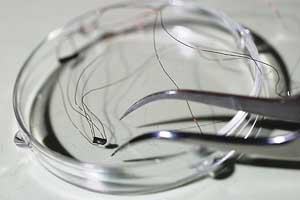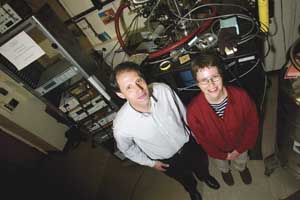Researchers develop sensors with ability to measure extremely large magnetic fields
By Steve KoppesNews Office
 The silver chalcogenides magnetic sensor, developed by researchers at the University and Argonne National Laboratory, has been used to make precise measurements of magnetic fields as high as 600,000 Gauss, or more than a million times Earth’s magnetic field. |
A research team led by Chicago physicists reported in the Thursday, May 23 issue of the journal Nature that they have combined non-magnetic materials into megagauss sensors, the most sensitive magnetic sensors ever developed for extremely large fields. The sensors’ potential applications range from medical imaging to a better understanding of the physics of high-temperature superconductivity.
Working at the National High Magnetic Field Laboratory at Los Alamos National Laboratory, the researchers used materials called silver chalcogenides to make extremely precise measurements of magnetic fields as high as 600,000 Gauss, or more than a million times the Earth’s magnetic field. Conventional techniques have difficulty measuring magnetic fields more than approximately 250,000 Gauss, resulting in less accuracy.
In the medical arena, the megagauss sensors would serve as a more sensitive detector for high-field MRI (Magnetic Resonance Imaging) applications.
“If you need to know the magnetic field very accurately, and if the field changes a lot over a small region of space, then these sensors would be very good,” said Thomas Rosenbaum, the James Franck Professor in Physics and the College.
The sensors also could be useful for studying the physics that underlie high-temperature superconductors, which have been touted for potential applications ranging from super-fast computers to levitating trains.
 Thomas Rosenbaum, the James Franck Professor in Physics, and Anke Hussman, formerly a postdoctoral researcher at Chicago, now with Toshiba Research Laboratory in Cambridge, have combined non-magnetic materials in the most sensitive magnetic sensors ever developed for extremely large fields. |
“One way to do that is to apply a magnetic field that kills the superconductivity and ask, what’s left? What does that so-called normal state look like? The magnetic fields you need for that are huge,” Rosenbaum said. “These large magnetic fields let you get at physics that you otherwise just can’t get at.”
A former postdoctoral researcher at Chicago, Anke Husmann, now with Toshiba Research Laboratory in Cambridge, England, led the study. Her co-authors also included Jonathan Betts, Greg Boebinger and Al Migliori of the National High Magnetic Field Laboratory at Los Alamos and Marie-Louise Saboungi at Argonne National Laboratory.
“The drive to obtain the highest possible magnetic fields cuts across disciplinary boundaries, but it has particularly potent implications for materials science,” wrote Husmann and her colleagues in their Nature article. That’s because magnetic fields change the way electrons move through solids. “The nature of these changes reveals information about the electronic structure of a material and, in auspicious circumstances, can be harnessed for applications,” they wrote.
The research team knew from previous experiments that silver chalcogenides, which consist of two parts silver, one part selenium and one part tellurium, showed no response to magnetic field. “But if you went with a tiny bit extra silver, say one part in 10,000, or a little more tellurium or selenium, all of a sudden the material was incredibly sensitive to magnetic field,” Rosenbaum said.
The team originally had planned to study silver chalcogenides to see if they could probe the structure of glassy materials by looking at the movement of electrical charge. But when they applied a magnetic field to the material, they observed an unexpectedly large response.
“This is a classic case of serendipity. We were looking for something different,” Rosenbaum said.
Rosenbaum noted that the sensors are small, cheap and sensitive. The sensors measure approximately one cubic millimeter, about the size of a pencil tip. The materials cost only pennies in those quantities, and they are capable of measuring extremely large magnetic fields with an accuracy of a fraction of a percent.
Last year, Husmann and Rosenbaum patented their sensors along with David Price and Saboungi (Argonne) and the late Rong Xu (Chicago and Argonne). The U.S. Department of Energy funded the research.
![[Chronicle]](/images/small-header.gif)